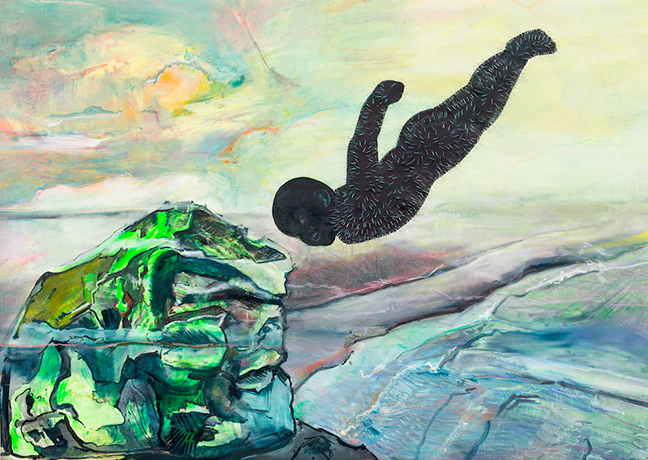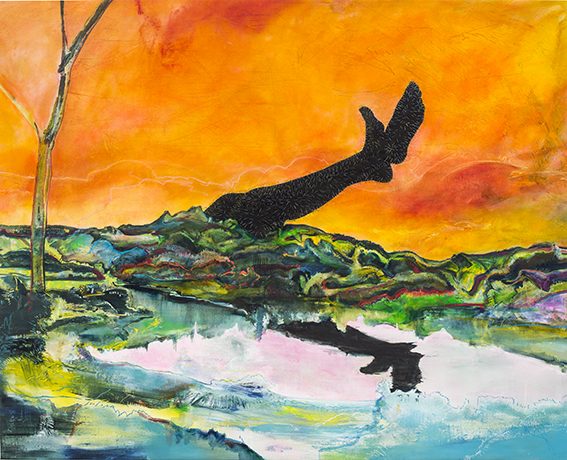
Cy Gavin
Overture
Sargent’s Daughters, New York
Until August 21, 2015
To Matters, 2015.
About:
Sargent’s Daughters is pleased to present “Overture”, the first New York solo exhibition of painter Cy Gavin. The exhibition is comprised of a series of twelve mixed-media paintings and will be open July 15th, 2015 through August 21st, 2015.
black is the color of my true loves hair.
In his debut exhibit, Gavin tackles a wide range of topics and influences- from the writings of W.E.B Du Bois to West African objects to his complex relationships with his family and his past. Gavin’s sexual orientation and artistic interests were an anathema to his Jehovah’s Witness family and his race set him apart in his rural hometown, making him an outsider even inside his own home. The sudden death of Gavin’s father, after a consistently bellicose relationship, caused Gavin to examine his family history and lack of documentation of his ancestry. His desire to depict his father and his relationship with him became a way to construct a past that only partially existed, just as the nebulous record keeping and mystery surrounding his origins allowed Gavin to explore the idea of a collective identity as well as an individual one.
Of major importance to Gavin is the “double consciousness” of black Americans lives. Du Bois describes this as “the veil” and the “two-ness” of being African American and American, writing in The Souls of Black Folk:
“One ever feels his two-ness, —an American, a Negro; two souls, two thoughts, two unreconciled strivings; two warring ideals in one dark body, whose dogged strength alone keeps it from being torn asunder.”
Emissary, 2015
In Gavin’s paintings this idea appears as two images: the hovering outline of a ghost, and an enigmatic black figure, whose opacity absorbs rather than reflects the surrounding light. To achieve this density of color, Gavin creates his own tincture incorporating tattoo ink, umber and translucent blue. This ultra-black figure becomes both a positive form and a shadow: an allegory of the African Diaspora in all forms. Often these figures are supine or floating- creating an impression of weightlessness and uncertainty, while curious protrusions emit from them like a sinister aura. The surrounding landscapes are rendered in searingly bright colors that both isolate and consume the figures, who are clearly at odds with their dazzling terrain. Some of the figures have staples or pins piercing their bodies, a reference to the Nkisi Nkondi—spirit vessels of the Kongo peoples into which nails are driven.
Spittal Pound, Bermuda, 2015.
In addition to the broad scope of his subjects, Gavin takes an unorthodox approach to materials and construction of his paintings. Working directly on unstretched canvas, Gavin works on the painting in an aggressive and occasionally ritualistic manner, listening to music to create a rhythmic motion. His scratching and erasure of the surface is a metaphorical reference to the erasure of African cultures in America’s history and challenges ideas of a mandatory assimilation to Western ideologies. This ceremonial method of creation extends to the materials in the paintings as well. Gavin incorporates his blood, hair, pink Bermuda sand and, in the case of Portrait Of My Father, his father’s ashes. The paintings thus become a carrier or vessel of these materials as well as Gavin’s work- giving credence to the first law of thermodynamics: matter cannot be created or destroyed, it can only change form. Exploring this same idea, Tolstoy writes in War and Peace:
“I feel I can never disappear because nothing disappears in the whole universe, and more than that, I always shall be and always have been in existence. I feel that other spirits exist, far above me, and it’s in their world that you will find truth.”
It is this same truth that Gavin brings to his paintings, and his expansive view of the human and spirit world draws together Gavin’s work and transforms it from a deeply personal expression to a manifestly universal one in which we are all, no matter our origins, engaged.
Cy Gavin was born in Pittsburgh, PA 1985 and received his BFA from Carnegie Mellon University in 2007. He currently lives and works in New York City, where he is an MFA candidate at Columbia University. This is his first solo exhibition in New York.



